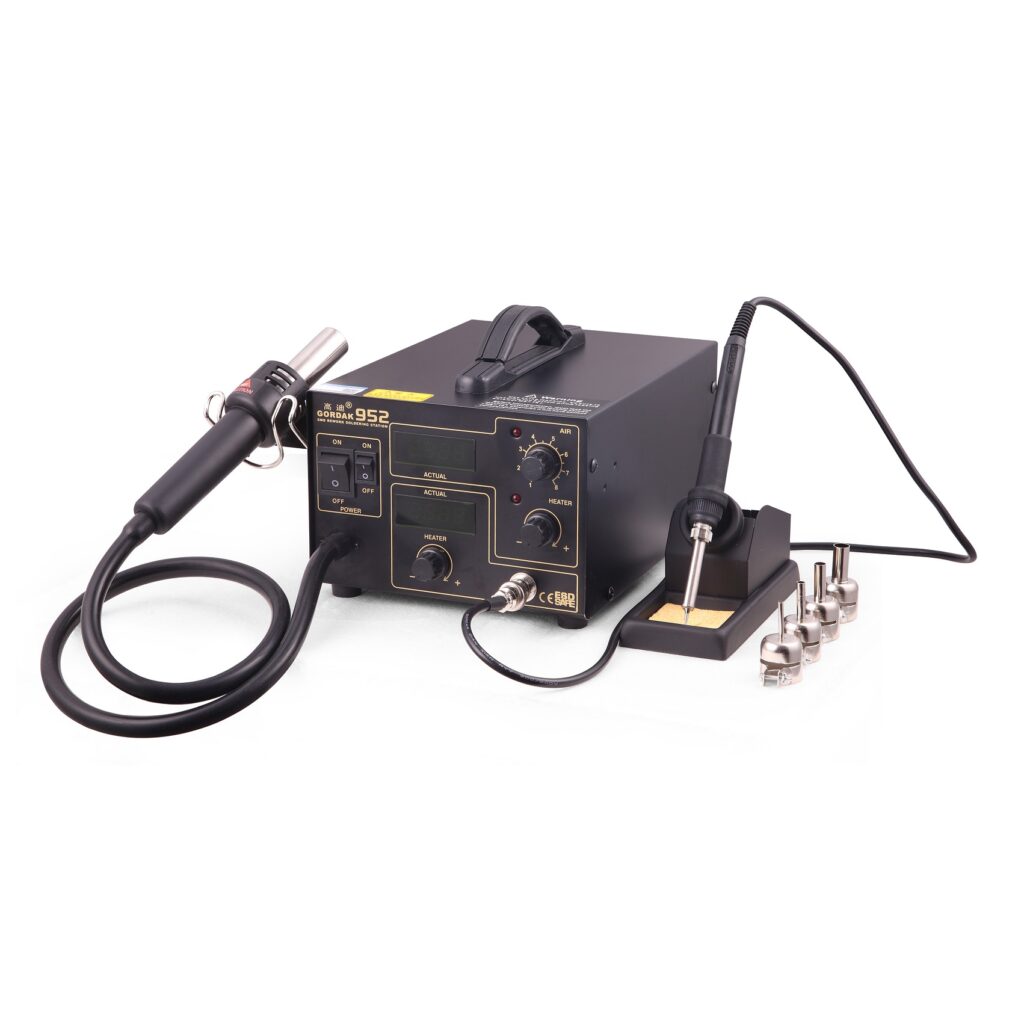A rework station is a critical tool in any electronics workshop, allowing for precise soldering and desoldering tasks. To ensure that your rework station continues to perform optimally and has a long lifespan, proper maintenance and calibration are essential. In this guide, Gordak Electric will walk you through the steps to maintain and calibrate your rework station effectively.
1. Regular Cleaning
- Importance: Dust, solder residue, and other debris can accumulate on your rework station, affecting its performance and potentially leading to damage over time.
- How to Do It:
- Daily Cleaning: Wipe down the exterior of your rework station with a soft, dry cloth to remove dust. For any stubborn spots, use a slightly damp cloth, but avoid using harsh chemicals.
- Soldering Iron Tips: Clean the soldering iron tips regularly by wiping them on a damp sponge or using a brass tip cleaner. This prevents oxidation and ensures better heat transfer.
- Nozzles and Filters: Clean the hot air nozzles and replace air filters regularly to ensure proper airflow and prevent blockages.
2. Inspecting Components
- Importance: Regular inspections can help you catch potential issues before they become serious problems, saving you time and money on repairs.
- How to Do It:
- Cables and Connectors: Check the power cables, connectors, and hoses for signs of wear, fraying, or damage. Replace any components that show signs of deterioration.
- Heating Elements: Inspect the heating elements in the soldering iron and hot air gun. If you notice any discoloration or uneven heating, it may be time to replace the elements.
- Displays and Controls: Ensure that all displays are functioning correctly and that control knobs or buttons are responsive.
3. Replacing Worn-Out Parts
- Importance: Worn-out parts can significantly reduce the efficiency of your rework station and lead to inconsistent results.
- How to Do It:
- Soldering Iron Tips: Replace tips that are heavily worn, pitted, or no longer transfer heat effectively.
- Nozzles and Heating Elements: Regularly check these components for wear and replace them as needed to maintain optimal performance.
- Filters: Replace air filters according to the manufacturer’s recommendations or when they appear clogged.
4. Calibrating Your Rework Station
- Importance: Calibration ensures that the temperature and airflow settings are accurate, leading to consistent and reliable results in your work.
- How to Do It:
- Temperature Calibration:
- Step 1: Allow the rework station to warm up to a stable operating temperature.
- Step 2: Use a thermocouple or a temperature probe to measure the actual temperature at the soldering iron tip or hot air nozzle.
- Step 3: Compare the measured temperature with the station’s display. If there’s a discrepancy, adjust the calibration settings according to the manufacturer’s instructions.
- Step 4: Re-check the temperature to ensure accuracy after adjustments.
- Airflow Calibration:
- Step 1: Set the rework station to a specific airflow setting.
- Step 2: Measure the actual airflow using an anemometer or similar device.
- Step 3: Compare the measured airflow with the expected value and adjust the calibration settings if necessary.
- Step 4: Confirm that the adjustments have brought the airflow to the desired level.
- Temperature Calibration:

5. Updating Firmware
- Importance: Some modern rework stations come with firmware that can be updated to improve performance or add new features.
- How to Do It:
- Step 1: Check the manufacturer’s website or user manual for firmware updates.
- Step 2: Follow the instructions provided by the manufacturer to download and install the latest firmware.
- Step 3: After updating, re-calibrate the rework station to ensure all settings are correct.
6. Storing the Rework Station Properly
- Importance: Proper storage helps protect your rework station from damage when not in use.
- How to Do It:
- Cooling Down: Always allow the rework station to cool down completely before storing it.
- Safe Storage: Store the rework station in a dry, dust-free environment. Keep it covered when not in use to prevent dust accumulation.
- Organizing Accessories: Keep nozzles, tips, and other accessories organized and stored in a clean, dry place to prevent damage or loss.
7. Documenting Maintenance and Calibration
- Importance: Keeping a record of maintenance and calibration activities helps you track the performance of your rework station and identify patterns or recurring issues.
- How to Do It:
- Logbook: Maintain a logbook or digital record where you note the date, type of maintenance performed, parts replaced, and any calibration adjustments made.
- Review Regularly: Periodically review the log to ensure that maintenance tasks are being performed consistently and to identify any potential areas of concern.
Conclusion
Proper maintenance and calibration of your rework station are essential to ensure its longevity and optimal performance. By following these steps, you can keep your rework station in top condition, leading to more accurate and efficient work in your electronics workshop. Regular attention to cleaning, inspecting, replacing parts, calibrating, updating firmware, storing properly, and documenting your actions will extend the life of your equipment and enhance its reliability.
For more tips or assistance with your rework station, feel free to reach out to Gordak Electric at info@gordakelec.com. We’re here to support your workshop needs with top-quality tools and expert advice.



